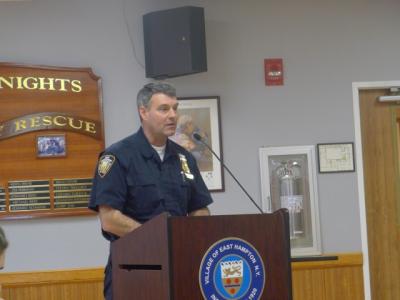The Tip of the Iceberg in East Hampton Village

Oversized basements that extend beyond the footprint of the house they are beneath are adding undue density and unanticipated living space to East Hampton Village, according to a discussion at the village board's meeting on Thursday
At the invitation of Mayor Paul F. Rickenbach Jr., Kenneth Collum, the village's code enforcement officer and fire inspector, told the board that, among the numerous residential renovations and tear-down or reconstruction projects in recent years, nearly all involve not only rebuilding to the limit of the allowed gross floor area but fully developing lower levels to include bedrooms and bathrooms as well as home theaters and recreation rooms. While these basements are not adding to a structure's mass, he said, they do add to a residence's density. This is a particular concern on smaller residential streets such as Mill Hill Lane, Meadow Way, and Conklin Terrace, he said.
Of 41 demolition permits issued last year, Mr. Collum said that 35 were for a tear-down and reconstruction. "We have seen where basements extend out underground," beyond the footprint of the house, Mr. Collum said, which led to questions about what should be included when calculating gross floor area. Zoning codes in surrounding areas, he said, do not regulate the gross floor area of basements. "If we do go forward with this, we're going to make a lot of nonconforming-use properties," he said. "We have to look at that as well." He suggested, as a first step, restricting the dimensions of basements to the physical footprint of the house.
Lys Marigold, the vice chairwoman of the village's zoning board of appeals, told the board of the phenomenon of "iceberg houses" in London. "What you see above ground is the tip of the iceberg," she said, explaining that residential structures there can extend three stories below ground level. "We're probably not going to have a rash of these because of the high water table that will prevent that much digging down," but she warned the board about applications before the zoning board in which multiple additional bedrooms are sought in subterranean spaces, which will inevitably add more cars and people to the village.
"The village in the summer can hardly handle any more cars," Ms. Marigold said. "It's a stretch on our ecosystem. . . . If each house on all these streets goes from three to six bedrooms, what is going to be the long-term implication? We have to think not only of our own properties, but to keep the village safely protected as our village," she said.
Richard Lawler, a village board member, voiced concern that such houses would then be rented, with the subsequent additional vehicles and attendant traffic and noise presenting a significant inconvenience to neighbors. With the emergence of short-term rental websites like Airbnb, Ms. Marigold said, "it's going to be explosive."
Board members discussed with Linda Riley, the village's attorney, how sensible regulations might be enacted while maintaining the rights of homeowners. "You need to zero in on what you see as the issue you want to address," Ms. Riley said, suggesting that with more bedrooms, more people can live in a house, meaning there would be more vehicle congestion. "If that's the issue, maybe we should focus the research there. I don't really know, sitting here, whether it would be lawful to limit the number of bedrooms in a basement. I could look into that. It's relatively unprecedented in this area."
"My concern is that if we go forward, we have to do a lot of due diligence to make sure we're not creating a huge zoning issue," Mr. Collum said. "We have to look at all those things to make sure we're not creating a lot of nonconforming properties."
The mayor called the discussion "an opening salvo" that represented a part of that due diligence. "We all recognize what's happening within the footprint of our beautiful Main Street and secondary bucolic roads," the mayor said. "To an extent, it's beyond our control." The board has a responsibility to "grapple with this problem," he said, and "if it means piecemeal, we'll certainly do it piecemeal." A working group would be appointed to study the issue in concert with the zoning and planning boards, he said, predicting an incremental, step-by-step approach.
